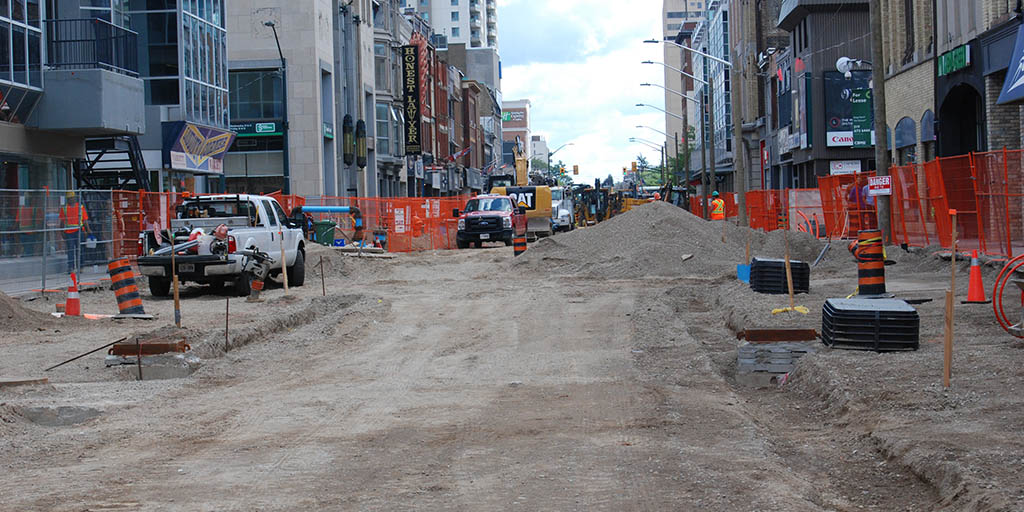Rare core construction season continues
 CREDIT: EMILY STEWART
CREDIT: EMILY STEWARTDundas Place continues its second phase of construction from Dundas Street between Richmond and Wellington streets. The Dundas Place construction also includes Clarence Street from King Street to Queens Avenue.
Construction and summer are two seasons that blend together.
During the summer of 2019, three core construction projects occupied the downtown core, with two still in the works.
The Core Construction section of the City of London’s website provided the projects’ information.
The King Street upgrades, including a new bike path from Colborne Street to Ridout Street, are finished. Meanwhile, the York and Talbot Streets’ sewer renewal project and Dundas Place’s phase two are still under construction.
The city’s website said Dundas Street is closed from Richmond Street to Wellington Street and at the Clarence Street intersection stay closed. The Dundas Place website said the construction, also known as phase two, expects to finish this winter.
Jim Yanchula, the city’s manager of downtown projects and business relations, said the intersection at York Street and Richmond Street is expected to reopen on Sept. 2. He added Talbot Street between York Street and King Street will be closed until the end of October, and York Street between Richmond Street and Clarence Street, where the VIA Rail station is located, will reopen whenever construction season concludes.
“People should be able to drive their cars on York between Talbot and Richmond, but not through Richmond, as of August 19,” Yanchula said.
Fanshawe College’s downtown campus dealt with Dundas Place’s phase one construction in 2018. In 2019, the construction’s impact on the commute for those part of School of Tourism, Hospitality and Culinary Arts varies.
Emma Rankin, the manager of Fanshawe’s Chef’s Table Restaurant and Café, said detours can make parking in the area challenging and rush hour traffic can also be an issue.
Rankin occasionally needs to go to Fanshawe’s London campus nearby Oxford Street from Downtown, and the commuting time between the campuses can be unpredictable and depends on construction in both areas.
“Sometimes you’re good enough to get it done in 10 minutes,” She said. “Another day, it might take you close to 40.”
Rankin said that although business at the restaurant can “fluctuate” during construction season, and summer “is a little bit slower for us”, she’s optimistic about the post-construction future for downtown.
“At the end of the day, it will benefit ourselves and the students as well for easier access,” she said.
Rankin added that during 2018’s Dundas Place construction, the students managed to get to class from the main campus area.
“Even though their apartments and places of residence are up there, they still managed with the bus and the city transit to get down here pretty easy,” she said. “The buses’ service is frequent and a lot of the students do have vehicles as well, so it hasn’t caused them that much of a challenge, I’m aware of.”
Claire Nguyen, a hospitality and tourism operations management student, said that during weekends, she and her fellow students deal with fewer buses and unpredictable schedules.
“We would just like the timing to be like, a bit concerned for us,” she said, adding that otherwise, the students enjoy travelling by bus and the “nice and friendly and helpful bus driver[s].”
Daryl Taylor, a hospitality service technician at the College, drives from Mount Brydges and walks to the downtown campus, so the construction hardly impacts him.
As for whether or not construction slows down business for the restaurant, Taylor said that since construction occurred during the restaurant’s nearly one-year longevity, it’s tough to say “until it all disappears and we find out what happens then”.
Yanchula said it’s unusual for more than one major downtown construction project to happen simultaneously, but then the federal government launched their Public Transit Infrastructure Fund, and the city wanted to take on the co-pay opportunity.
“To take advantage of that funding when it was offered was a prudent financial move,” he said. “Otherwise we’d be spending dollar for dollar rather than 50 cent dollars out of the municipal taxpayer base.”
Yanchula said Dundas Place costs $16 million for “non-hydro work” about $10 million in hydro work. In a follow-up email with Interrobang, he said the 2019 engineering and construction work for the York Street sewer renewal project cost around $7.5 million.
He said updating the sanitary and storm sewers, which have 150 year old and older underground infrastructure, will clean the sewers and make them more environmentally friendly.
“Right now, whether you flush your toilet or the drains in the streets, they all drain into the same pipe. It’s all mixed up. It’s not good for the Thames River and we have to meet current environmental standards.”
For an efficient commute, Yanchula said plan ahead by allowing “yourself more time than you think it takes” and checking resources like Core Construction and Renewal London on the City of London’s website and Waze app for traffic updates before hitting the road.














